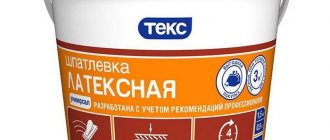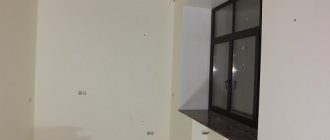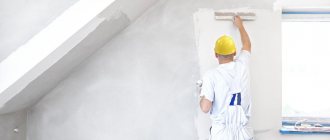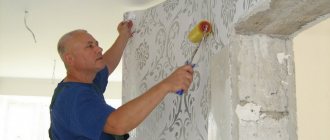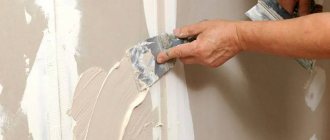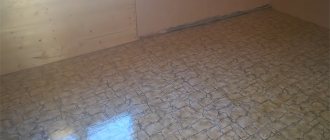Wallpapering walls is the most popular type of finishing.
The quality of the pasting largely depends on the condition of the base.
A prerequisite for preparing the base for wallpapering is puttying.
Putty walls are a perfectly flat and smooth surface.
Figure 1. Puttying walls for wallpapering.
Why putty the walls?
Puttying surfaces allows you to eliminate minor defects and flaws: cracks, chips, scratches and unevenness.
The adhesion of the wall surface to the wallpaper improves, and the strength of the base increases.
Due to reduced water permeability, glue consumption is reduced.
A homogeneous white putty surface will ensure uniform color even with translucent wallpaper.
Depending on the type of wallpaper, different requirements are imposed on the preparation of walls:
- liquid wallpaper does not require careful leveling, since its textured surface hides small cracks and irregularities;
- thick vinyl wallpaper will hide minor flaws;
- thin wallpaper requires a perfectly flat base, since the slightest defects and irregularities will be reflected on the pasted surface.
If the walls are finished with plasterboard, puttying them is also necessary. Putty will increase the strength of the surface of the sheets, improve adhesion and prevent the cardboard layer from damage when removing the wallpaper.
Is reinforcing mesh necessary?
You can often come across the opinion that wallpaper additionally strengthens the surface of the wall and therefore there is no need to use reinforcing materials when filling. This is only partly true; this rule is not true for all types of bases and types of wallpaper.
As a rule, reinforcing putty is practiced when preparing walls for painting in order to eliminate the formation of cracks that cannot be hidden in any way. Exactly the same approach should be practiced if the decoration will be carried out with thin, light-colored wallpaper, for example, paper or vinyl on a non-woven backing. In addition to the fact that cracks can show through the canvas in the form of dark stripes, they can also lead to rupture of the wallpaper itself.
Continuous reinforcement of the wall surface is not required in panel-type houses or if the base is made of sheet materials. You can also avoid laying mesh in putty if the house stands on a reliable foundation and is made of large-sized masonry material with a small joint thickness, for example, aerated concrete blocks. Reinforcement of the finishing layer is required when processing brick walls, especially those made of half a brick. It is also possible to recommend strengthening the entire surface of walls in secondary housing facilities and private houses over 30 years old. In panel houses or if the base is made of sheet materials, gluing one or two layers of reinforcing mesh in the corners and joints is required.
What is mandatory when puttingtying walls is priming. It is carried out twice on the rough surface, and then intermediately before applying each new layer. For priming under putty, use acrylic-based adhesive primers. Since the putty layer is minimal, it is not necessary to limit the moisture absorption of the base.
Tools and materials
Puttying walls requires the presence of tools and devices, without which high-quality work is impossible:
- A drill or hammer drill with a special mixer attachment for preparing putty. The device will help achieve a homogeneous, uniform composition.
Figure 2. Drill with attachment.
Important!
It is almost impossible to make a putty solution from dry mixtures without using a mixer, so if you don’t have one, buy putty in the form of a ready-made paste.
- A container in which we will stir the mixture. It is good to use round-shaped construction basins made of impact-resistant plastic for this. They are easy to clean, convenient to mix the solution and collect the mixture.
Figure 3. Construction basin.
- Rule for leveling thick layers of putty in case of significant deviations.
Figure 4. Rule.
- Spatulas with a width of 300 and 100 millimeters for distributing and leveling putty. Choose a tool with a perfectly straight blade and a comfortable handle.
Figure 5. Wide spatula.
Important!
A wide spatula is the main tool when applying putty. Choose it in a higher price segment, because the ease of application and the quality of the putty surface depend on the evenness and reliability of the blade.
- Special profile spatulas for finishing internal and external corners.
Figure 6. Angled spatulas.
- A manual grater-skinner on which sandpaper or a special mesh is attached for grinding the surface.
Figure 7. Devices for grinding putty surfaces.
- A fur or foam roller for applying primer and a painting tray for distributing the composition and removing excess.
Figure 8. Paint roller and tray.
- Construction level for constant monitoring of the straightness of the wall.
Figure 9. Construction level.
- Protective equipment: gloves, goggles, respirators to protect against dust and small particles formed when sanding putty layers.
Figure 10. Gloves, glasses, respirator.
In addition, you will need materials:
- Primer for treating walls before filling and before wallpapering. It is better to choose formulations with antiseptic additives to protect against mold and other microorganisms;
- Putty mixtures for starting and finishing layers.
- Special polymer-based putties for leveling significant unevenness.
- Serpyanka tape for reinforced joints between sheets of drywall.
TOP 3 best products according to customers
Putty Basic cement Prospector 20 kg
240.00 rub.
Product code 12155
Purpose: Used for leveling walls made of concrete, brick, plaster indoors.....
Gypsum putty Knauf Uniflott/Knauf Uniflot 5 kg
550.00 rub.
Product code 294
The dry mixture is a fine powder of gypsum and modifying polymers. AREA P…..
Universal gypsum putty Knauf Fugen/Knauf Fugen white 25 kg
420.00 rub.
Product code 268
Dry putty Knauf Fugen with a fine-grained structure made of natural gypsum and polymer modifications.....
Types and purpose of putties
The construction market offers a large assortment of ready-made paste putties and dry mixtures that need to be prepared immediately before starting work.
You need to choose a mixture taking into account the characteristics of the walls and the type of wallpaper.
Ready-made putties are very easy to use; no mixer is required for stirring; the finished mixture is stored for a long time in a closed container. Its significant drawback is its too high cost.
Dry mixtures are much cheaper and are not inferior in quality to ready-made mixtures. This putty should be used immediately after preparation.
There are starting, finishing and universal putties.
The starting putty is made from components with coarser grains and creates a strong base with good adhesion for applying the finishing layer.
The finishing putty consists of finely ground gypsum powder, capable of creating an impeccably smooth, glossy base for any type of wallpaper or color.
Universal mixtures are suitable for applying any layers in several stages.
Cement
They are resistant to moisture and temperature changes. Used for leveling walls made of concrete and brick. Suitable for finishing kitchens and bathrooms.
Figure 11. Cement putty.
Plaster
Plastic, easy-to-use putties. Perfectly eliminates unevenness and defects in the base. They are environmentally friendly and safe. They create breathable surfaces that can regulate humidity and create natural air exchange in rooms.
They do not lose their properties within two hours after production.
Can be applied in a layer of up to 30 millimeters. Suitable for starting and finishing coats.
Figure 12. Gypsum putty.
Polymer
Modern polymer-based putties, characterized by plasticity, impeccable smoothness of treated surfaces and cost-effectiveness. Can be applied in layers up to 0.5 millimeters. There are latex and acrylic. There are starting and finishing acrylic mixtures, suitable for any substrate. Latex ones are used for finishing leveling and are able to eliminate even the smallest flaws, creating a perfectly flat surface. The most expensive type of putty.
Figure 13. Polymer putty.
Water-dispersed
Acrylic or latex based putties with high performance qualities. Suitable for leveling any base, even wood, concrete or fiberboard. Due to the presence of resins, the putty dries quickly after application, but is easily diluted with water if the mass thickens.
It is characterized by high moisture resistance, resistance to high temperatures, good adhesion and shrinkage resistance. It belongs to the middle price category and is produced completely ready for use.
Figure 14. Water-dispersion putty.
All putties are suitable for leveling walls under wallpaper; it is only important to choose mixtures that are suitable for the base, type of wallpaper and are affordable for you.
I recommend!
If you do the puttying yourself, purchase a ready-to-use polymer-based mixture. It has an ideal consistency, is easy to apply and can be stored for a long time in a closed container.
Which is better?
When gluing wallpaper, it is important to choose the right type of putty.
There are many options on the market, but few realize that not only starting materials, but also finishing materials are suitable for the job.
The latter are applied when the surface is already smooth and there are no obvious or hidden flaws on it.
Finish
However, if the walls are far from flawless, you need to start with a starting material, preferably of the gypsum type. However, if the wallpaper will be glued to the walls of the bathroom or kitchen, it is more rational to opt for a cement material.
It is distinguished by its excellent resistance to moisture, it is strong, durable and will serve for many years. In the interval between the balls, and immediately before the procedure for sizing the material, the surface must be primed.
Initial mixtures are characterized by a high degree of strength and adhesion to other materials. But they have one significant drawback: coarse grain size. It is rational to use them exclusively for the purpose of rough leveling after the plastering has been carried out.
The ball should be applied in a thickness of 0.3 to 2 centimeters . The indicator varies so much due to different degrees of unevenness.
Preparing walls for puttying
Walls to be puttied must be cleaned of old coatings, peeling plaster, oil stains, dirt and dust.
To remove wallpaper, you can moisten it with water using a roller or brush. You can make notches on thick vinyl wallpaper for better moisture. We remove the wallpaper by prying it off with a scraper or spatula, starting from the joints.
Figure 15. Removing old wallpaper.
It is better to completely remove oil-based paint with a scraper or using a grinder with a stiff brush attachment. Heat treatment with a hair dryer or gas torch will make paint removal easier.
Figure 16. Heat treatment for paint removal.
We remove old whitewash from walls and ceilings using a wet sponge and spatula, having previously soaked it.
We remove damaged areas of plaster using a spatula or a hammer and chisel.
We fill out the cracks and wash them thoroughly with water to remove dust.
After cleaning the walls, we check them for evenness.
We treat the surface requiring repair with primer mixtures.
In case of significant damage, unevenness and deviations, we level the walls with ready-made repair compounds, gypsum or cement plaster. We carefully repair all cracks and chips.
Figure 17. Repair of old plaster.
The dried plaster layer must be sanded with coarse sandpaper.
After the repair is completed, we prime the entire surface with penetrating primers with antiseptic additives that prevent the appearance and development of mold.
The primer will increase the adhesion of the base to the putty and extend the service life of the finish.
Figure 18. Priming surfaces.
We apply priming with a roller or brush in two layers. Apply the second layer after the first has completely dried.
If there are plasterboard walls, we cover the joints and seams with serpyanka mesh to prevent cracks from appearing during operation. We cover the sheets with primer. We fill the recesses from the screws and the joints of the sheets with starting putty.
Figure 19. Preparing plasterboard walls for puttying.
Features of working on different surfaces
Leveling walls with putty is quite simple if you follow the recommendations of specialists. However, it is important to consider the features of working on each type of surface.
- Wooden surfaces are not capable of supporting a layer of putty whose thickness exceeds 3 mm. Before applying the composition to the walls, it is worth treating them with several layers of deep penetration primer.
- Brick walls are perfectly plastered. This is especially true for surfaces with smooth masonry. Most often, 2-3 layers of starting putty (coarse-grained) are applied to brick surfaces.
- Concrete walls. Concrete can be puttied only after a layer of concrete contact primer has been applied to it. It is recommended to apply a layer whose thickness does not exceed 5 mm.
- Plaster. The application technique involves the use of all standard steps.
- Drywall is a material that must be puttied, paying special attention to the seam area. Following this recommendation will allow you to avoid such a nuisance as removing the paper surface of the drywall when removing old wallpaper from the walls.
When starting repairs, it is important to decide what type of surface will be puttied and become familiar with the specifics of the work.
How to calculate the required amount of putty
Before purchasing putty, you need to correctly calculate the required amount. The average consumption of the mixture can be found on the packaging.
Material consumption depends on many factors:
- Areas of leveled surfaces. It can be determined by measuring the perimeter of the room and multiplying it by the height of the wall.
- The thickness of the applied layers, which directly depends on the size of the irregularities and deviations. The size of the irregularities can be easily determined by applying a two-meter strip to the walls. We measure deviations from the vertical using a plumb line.
- Wall material. Depending on the material of the walls, we select the type of putty. Smooth plastered walls can be covered with a thin layer of polymer or water-dispersion putty, up to 1 millimeter layer.
- Type of putty. The consumption of cement putties is much higher than latex or acrylic ones.
The average starting putty, with a layer thickness of two to five millimeters, will be from one to three kilograms per 1 m2. The consumption of cement or gypsum putties with a layer of 6-9 millimeters will increase from four to six kilograms per square.
The final coating is applied in a layer of no more than one millimeter, and ranges from 500 grams to 1.5 kilograms of putty per square meter.
Wall putty technology
The quality and durability of the final finish depends on the correct preparation of the putty, adherence to the technology and procedure for performing the work.
We carry out puttying at positive outside temperatures, not lower than ten degrees.
We carry out the work in the following sequence:
1.Preparing putty
We dilute dry construction mixtures strictly following the manufacturer’s recommendations.
Pour the dry mixture into a container with water at room temperature, based on the production of the solution within the estimated time indicated on the package.
Stir the solution with a mixer until it reaches a homogeneous, easy-to-work plastic consistency.
I recommend!
After producing the solution, rinse the container and all tools with water. Even the smallest grains of dried mortar can ruin the entire work, leaving streaks and furrows.
To improve the ductility, strength and reliability of the coating, we add PVA glue, deep penetration primer and hydrophobic additives.
Mix the mixture thoroughly using a mixer or drill with a special attachment.
Figure 20. Preparation of putty.
Mix the prepared putties thoroughly with a mixer at low speed. Slight dilution with water is allowed, but not more than 30 milliliters per kilogram of composition.
2. Starting layer
Using a small spatula or trowel, the putty is taken from the container and applied to a wide spatula.
The leveling mixture is applied to the base using a wide spatula, holding it at an angle of approximately 45 degrees.
Figure 21. Applying putty.
We start the work from the bottom from the corner of the wall, distributing the solution in an even layer over the surface with smooth zigzag movements.
We putty the corners of the room using a special corner spatula. It makes the job much easier by creating a perfectly even 90-degree angle.
Figure 22. Puttying corners.
The thickness of the starting layer can be from one to three millimeters. If it is necessary to apply a thicker layer, the wall must be reinforced with a mesh of fiberglass or polymers. In this case, the mesh should be in the mass of the putty solution.
Figure 23. Reinforcement of the putty layer.
Rub the dried starting layer with a hand grater with a mesh attached to it or fine-grained sanding paper. Large surfaces are best treated with an electric grinder.
We control the evenness of the surface using the rule.
The putty dries, depending on the thickness of the layer, temperature, humidity and the presence of ventilation in the room, for at least 24 hours.
In hot, dry weather, for uniform drying, the putty surface must be periodically moistened.
3. Finishing layer
The finishing layer is applied to the completely dry starting putty.
The solution for this layer should be of a more liquid consistency and applied with a thickness of no more than one or two millimeters.
The finishing layer must be applied in two layers, the second - after the first has completely dried.
Figure 24. Grouting putty.
The first layer is sanded with fine sandpaper, and the final layer is sanded with a leather or suede pad.
The finishing layer should completely hide the smallest irregularities and pores in the coating and create a perfectly smooth surface.
Application
To apply the primer, it is rational to use a special roller, which will ensure maximum uniformity of this process. especially carefully (for this, an exclusively narrow brush is used).
Primer
The putty material itself is applied only to dry surfaces! The instrument must be cleaned and washed. This is because dry lumps of the old mixture can easily get into the selected area. If such particles get underneath the base material, they can cause defects on the surface.
In addition, on a “rough” surface it is almost impossible to glue wallpaper so that air bubbles do not appear under it. With a smooth plasterboard wall, you only need one final ball.
Application to drywall
If the surface was previously leveled with plaster, and repairmen doubt the quality of the material, it will be necessary to apply several layers of material.
Before wallpapering, the surface will still need to be thoroughly sanded.
Grinding
This process is very painstaking and requires a lot of effort: arm yourself with a lamp and direct its light along the wall. At this time, it is important to look at all the defects and eliminate them as thoroughly as possible.
From the very beginning you need to pay attention to the instant mixture. To do this, place the required amount of powder into the tank (basically, up to five kilograms will be enough for the initial stage), and then start pouring water into it.
The resulting mixture must be constantly stirred to prevent the formation of lumps . Here you should use a mixer with an attachment.
Preparing the mixture
The consistency of the mixture should resemble sour cream. It is important to mix the material for work only before starting work.
Each ball of material applied must be the same thickness.
The work is done this way:
- With a small tool, a small portion of material is collected, which is transferred to a large spatula;
- the spatula with the material must be held at an angle of 25 degrees to the surface, then the contents are slowly transferred to the wall from its right edge;
- With a few more additional movements, the putty is distributed more evenly;
- Ideally, all movements of the worker should be diagonal , in this way it is possible to achieve uniform distribution of the solution.
Then similar manipulations can be carried out, starting from the opposite edge of the wall, overlapping. In this way, the formation of bumps and sharp transitions can be prevented. The first layer will never turn out perfectly smooth; even a master cannot do this.
Basically, several balls of putty can be applied to the average surface being treated. How long should putty dry? Between applying each layer it is necessary to pause for a day.
For more information about applying finishing putty, watch the video:
Useful tips
When starting puttying work, listen to the advice of professionals:
- When purchasing ready-made putty mixtures, pay attention to the production time. It is better if they were produced no more than two months ago.
- Buy putty from reliable construction supermarkets. Here, unlike markets, storage conditions are observed and there is less chance of stumbling upon a fake.
- Use putty from the same manufacturers for the starting and finishing layers. They are most compatible with each other.
- The main tool when applying putty is a wide spatula. Choose it in a higher price segment, because the ease of application and the quality of the putty surface depend on the evenness and reliability of the blade.
- Take precautions when preparing the solution and sanding the surface, protecting your eyes, skin and respiratory tract from contact with dry components. Wear rubber gloves, goggles, respirators and special protective clothing. Keep animals and children away from work.
- Do not pour dry mixtures or putty residues down the drain or throw them in the garbage chute.

